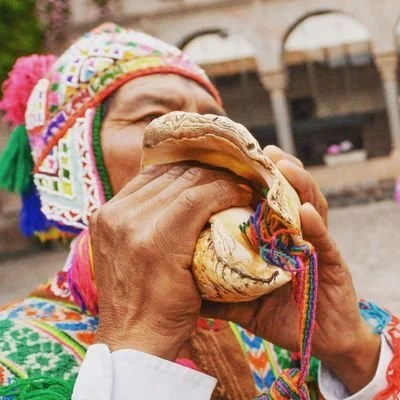Image courtesy of El Diario Bolivia
By Alicia Badault
According to the Cambridge Dictionary, the word indigenous means people inhabiting or existing in a land from the earliest times or before the colonists' arrival. Indigenous culture is often overlooked and generalised, and when we think of indigenous people we often envision some stereotypes that we associate with most North American tribes. But there are indigenous people everywhere, and although indigenous stories are shared throughout South America, today I am going to concentrate specifically on one story, that of the Aymara. Archaeologists have found evidence that the Aymara people have lived around western Bolivia for at least 5,000 years, but they are also descended from cultures that came before them. They are natives who live high in the Andes and Altiplano Mountains, with distinct traditions in colourful textiles and music that they've developed over thousands of years. This tribe has a particularly special place in my heart because my grandmother is originally from this community. In this article I wanted to touch on what I consider to be the most interesting tradition the Aymara have, since all indigenous communities have their own celebrations and customs as well as their own culture and traditions. This tribe is also spread across Bolivia, Argentina, Chile, and Peru. Like other indigenous people, the Aymara believe in a mixture of their indigenous religion and Roman Catholic beliefs. They believe that spirits live in the mountains, sky, and lightning. The most powerful and holy spirit is Pachamama, the Earth Goddess, who controls how well crops grow. Although today the Aymara people live in an area spanning three different countries, they are united by a flag called the wiphala, which has seven colours.
Music is very important in Aymara culture. As I stated, the Aymara have developed their own sounds and music over thousands of years and they also have their own traditional instruments. The most common instruments are homemade violins, drums, panpipes, and Pututu, made from a cow’s horn. They also have their own version of flutes called sikuris and laquitas. Other instruments used are a pinquillo, a kind of long quena (Andean pipe), and a wankara (an instrument similar to a bombo, an Argentinian drum). Aymara music includes many songs dedicated to llamas and alpacas, animals that are essential to the subsistence of the Aymara people living on the Altiplano. And in some songs, they express the love and affection they have for their animals. But above all music plays a central role in the sacred and traditional spheres of life.
Sikuris, image courtesy of Getty Images
Pututu, image courtesy of @PututuQepachi on twitter.com
I think one of the traditions of the Aymara that I find the most captivating is the Tata Jach'a Danzanti. Jorge Sanjines' 1989 film La Nación Clandestina showcases it in great detail. It is practiced in the Aymara culture, specifically in the Pongonhuyo-Achacachi communities of the Omasuyos province of La Paz. Tata Jach'a Danzanti translates roughly to ‘Great Lord Dancer’, and in the film this tradition is used to punish those who have wronged their community, forcing the punished to dance until they die. The book titled El arte folklórico de Bolivia (the folkloric art of Bolivia) by Rigoberto Paredes, describes the one punished as “un hombre ofrendado a los dioses, quien debía bailar durante tres días sin descanso, hasta que la muerte lo doblegue” ( man offered up to the gods, who would have to dance 3 days without rest until death defeats him). This is done so that their souls can be purified and offered to the Pachamama. The Aymara also believe that when one dies it increases fertility in the community. The characteristics of the El Tata Jach’a Danzanti dance are that it has peculiar rhythms with four beats per bar, which are repeated throughout its duration. A colourful costume is worn, comprising a blazer along with a skirt or leggings and brogues. In addition, a heavy mask with an undefined zoomorphic shape is worn. It looks somewhat like a toad, with large ears and pronounced lips. It is said that when putting the mask on, the body enters a state of peace and quiet, and you are only able to listen to the sound of the music, turning to its beat always towards the right so as not to wake the bad spirits. Originally weighing 50kg, the green mask is said to signify colonisation and is supposed to resemble a dehumanised form of how the Aymara saw the Spanish when they were colonised.
La Nación Clandestina, image courtesy of medium.com
I’ve only touched on very little of their culture and one of the rituals that I found the most interesting and unique. But there are many more traditions and practices that stem from the Aymara people. They have a beautiful connection to nature, spirituality, life, and each other. The Aymara truly embrace the values of community and always stay united.
Alicia Badault Is a French/Bolivian 3rd-year film student, who aims to educate about primarily indigenous Bolivian culture and stories through her writing





